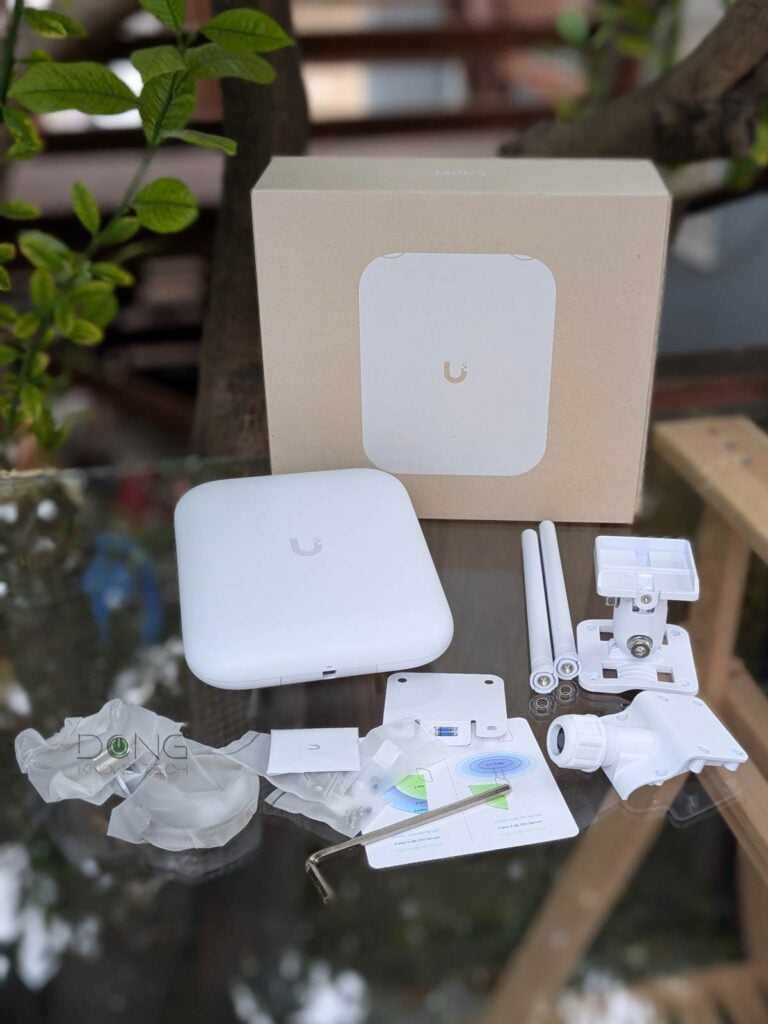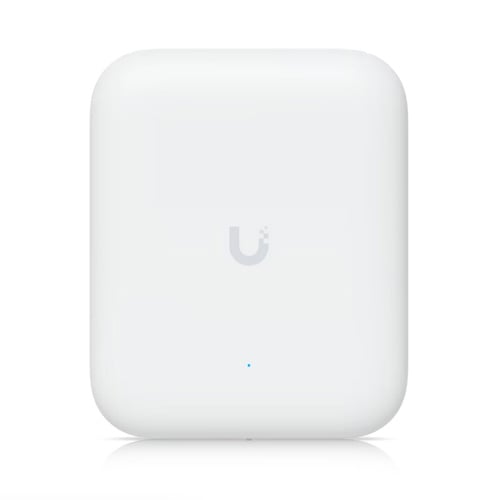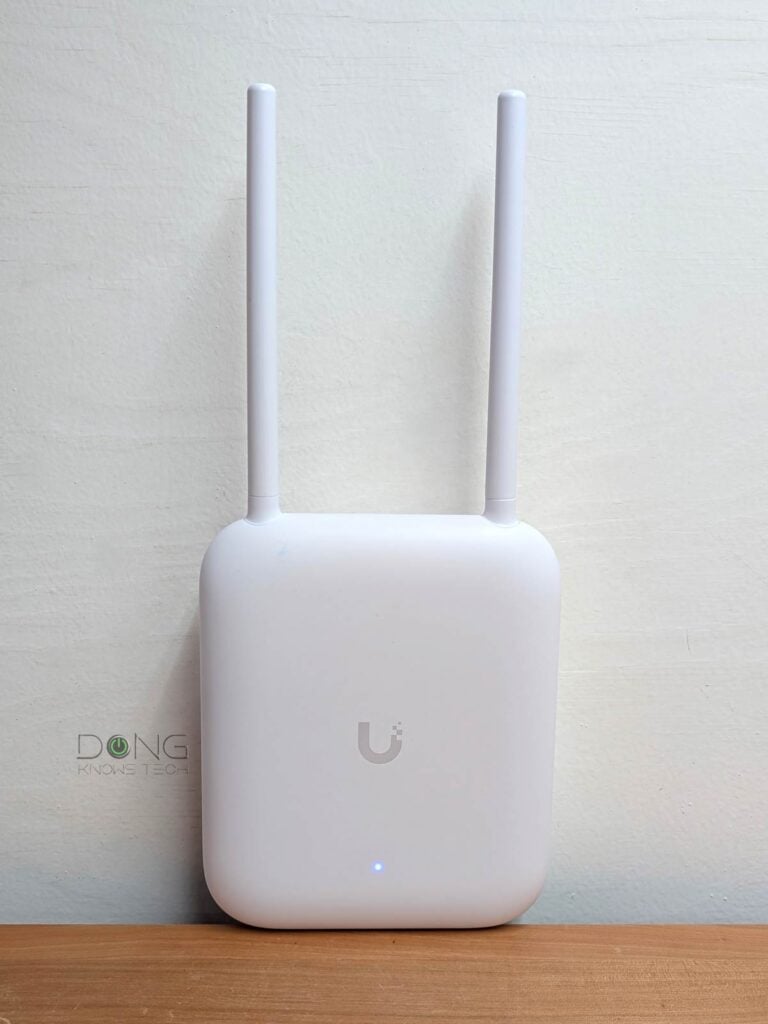The U7 Pro Outdoor is part of Ubiquiti’s original U7 Pro family of access points, which first came out in January 2024 and was then replaced by the U7 Pro Max in September of the same year. However, it’s a totally different beast.
For one, it was released in early 2025, together with the refreshed and upgraded U7 Pro XG and U7 Pro XGS. Secondly, it’s Ubiquiti’s second consumer-friendly standard Wi-Fi 7 access point that features the coveted AFC feature, after the UniFi E7.
Here’s the bottom line: If you have a sprawling yard or large ranch, the U7 Pro Outdoor is an excellent access point to cover it with a fast Wi-Fi 7 signal reliably, totally worth the sub-$300 suggested retail cost—its street price varies. Get one or a couple today, depending on the size of your property. When you’re at it, make sure you have a UniFi console to match. I’d recommend the UCG-Fiber.


U7 Pro Outdoor: A reliable Wi-Fi 7 solution with extensive coverage
As mentioned, the U7 Pro Outdoor shares the same Wi-Fi and PoE specs as the U7 Pro. Both are mid-tier Wi-Fi 7 access points with a 2.5Gbps PoE+ port as the sole powering method. You need to use either a PoE switch or an injector—neither is included.
In terms of class, both are part of Ubuquit’s Flaghip family, with the Outdoor being also part of the, well, Outdoor category.
Tip
Ubiquiti has a few categories of Wi-Fi access points, including:
- Flagship: These are high-performance, ceiling-mounted access points.
- Outdoor: Weatherproof APs that can be mounted to poles outside or conveniently placed on a surface indoors.
- Enterprise: Top-capacity APs with 1,000+ client support, long-range 6 GHz performance, and 10 GbE PoE connectivity with native high-availability architecture for critical enterprise environments.
- Wall: These are sleek APs that plug directly into a wall outlet for meshed connectivity or transform an Ethernet drop into an AP.
- Mega Capacity: APs that are designed for stadiums or amphitheaters with a very high density of connected devices.
- Bridging: Devices that serve as a high-performance network bridge without the wire.
A UniFi access point can belong to multiple categories. The E7 Audience, for example, is an enterprise outdoor access point with mega capacity.
What makes the U7 Pro Outdoor different from standard UniFi access points is the fact that it’s designed for outdoor use with IPX6 ruggedness out of the box. It’s a square box designed to handle water splashing right out of it. It includes pole mounting accessories and a cable-gland door kit to upgrade its ruggedness to IP67, meaning it’s dust-tight and can withstand water submergence.
On the underside, where its port is, the U7 Pro Outdoor comes with a thick metal base that’s likely designed to work as the heatsink. The AP has no intenral fan. It’s a solid piece of hardware.
Other than internal antennas, the U7 Pro Outdoor also comes with two optional external antennas that can be attached to its top without hindering its IP67 ratings. With these two, it’s slated to have much larger Wi-Fi coverage compared to any indoor access point. Other than that, the U7 Pro Outdoor also has AFC, which proved to be a bit complicated as you’ll find below.


The table below shows how the U7 Pro Outdoor compares to the U7 Pro with the U7 Pro Max as the reference.
U7 Pro Outdoor vs. U7 Pro vs. U7 Pro Max: Hardware specifications
  |
  |
  |
|
| Model | U7 Pro Max | U7 Pro Outdoor | U7 Pro |
| Wi-Fi Standard | Tri-band BE15000 | Tri-band BE11000 | |
| 2.4GHz Band (channel width) |
2×2 BE: Up to 688Mbps (20/40MHz) |
||
| 5GHz Band (channel width) |
4×4 BE: Up to 8.5Gbps (20/40/80/160/240MHz) |
2×2 BE: Up to 4.3Gbps (20/40/80/160/240MHz) |
|
| 6GHz Band (channel width) |
2×2 BE: Up to 5.7Gbps (20/40/80/160/320MHz) | ||
| Dedicated Spectral Scanning Radio | Yes | No | |
| Zero-DFS | No | ||
| Backward Compatibility | 802.11ax/ac/n/g/a/b | ||
| Max Concurrent Clients | 500 | 300 | |
| Antenna Gain | 2.4GHz: 4 dBi 5GHz: 6 dBi 6GHz: 5.9 dBi |
2.4GHz: Directional internal: 8 dBi, 90° x 90° External omni: 6 dBi, 360° x 15° 5GHz: Directional internal: 11 dBi, 90° x 45° External omni: 8 dBi, 360° x 15° 6GHz: Directional internal: 10 dBi, 90° x 45° |
4 dBi 6 dBi 5.8 dBi |
| Multi-Link Operation (MLO) |
Yes | ||
| Automated Frequency Coordination (AFC) |
No | Yes | No |
| Broadcasting Power | 2.4GHz: 23 dBm 5GHz: 29 dBm 6GHz: 23 dBm |
2.4GHz: 23 dBm 5GHz: 26 dBm 6GHz: 20dBm or 26 dBm (with AFC) |
2.4GHz: 23 dBm 5GHz: 26 dBm 6GHz: 23 dBm |
| Estimate Wi-Fi Coverage (vendor estimate) |
1,750 ft² (160 m²) |
5,000 ft² (465 m²) |
1,500 ft² (140 m²) |
| Power over Ethernet (PoE) |
802.3at (PoE+) |
||
| Max Power Consumption | 25W | 21W | |
| Internal Cooling Fan | Yes | No | Yes |
| Network Port | 1x 2.5Gbps Multi-Gig PoE+ | ||
| Security | WPA, WPA2, WPA3 | ||
| Local Web-based Management | No (as a standalone AP) |
||
| Cloud-Management | Yes (free) |
||
| Mobile App | UniFi | ||
| Mode | Access Point | ||
| Dimensions (without mount) |
Ø8.1 x 1.8″ (Ø206 x 46 mm) | 170 x 208 x 66.5 mm (6.7 x 8.2 x 2.6″) | Ø8.1 x 1.8″ (Ø206 x 46 mm) |
| Weight (with mounting accessories) |
1.5 lb (680 g) | ||
| Pole Mount Diameter | n/a | 1–2.5″ (25–63.5 mm) | n/a |
| LED | Color-changing (White/blue) LED ring | Color-changing (White/blue) LED dot | Color-changing (White/blue) LED ring |
| US Launch Cost (Compare specs and pricing!) |
$279 | $189 | |


The complicated 6GHz, and, consequently, AFC
As mentioned, the U7 Pro Outdoor is the second consumer-friendly access point from Ubiquiti that supports AFC, besides the E7. Unlike the E7, which is an indoor unit, the U7 Pro Outdoor’s AFC support proved to be a bit more complicated, likely due to the nature of the 6GHz band and the Automated Frequency Coordination feature itself.
During the setup process, I was asked to enable this band or not. Enabling it also means AFC is enabled. Unlike the E7, the U7 Pro Outdoor lacks a separate switch to disable AFC, allowing the 6GHz band to be used in the standard manner. There’s an Outdoor and Indoor profile within the web user interface, but there’s no difference in terms of broadcasting signal in my experience.
It’s worth noting that the U7 Pro Outdoor 6GHz band’s broadcasting power changed between 20 dBm and 26 dBm, with the latter indicating the use of AFC. The former took place most of the time when I used the AP indoors.


All these adjustments mean the 6GHz band takes a long time to be ready, likely because the hardware needs to scan the airspace to make sure its AFC complies with the regulation—in addtion for DFS scanning for its 5GHz band. And here’s the pain point: The AP’s 6GHz didn’t work with many 6GHz clients I tried. Specifically, none of my Wi-Fi 6E devices could detect its SSID, and neither could some Wi-Fi 7 devices. However, with those that could, the performance of this band, as well as its range, proved excellent.
A familiar UniFi access point
Other than that, the U7 Pro Outdoor proved to be a familiar UniFi access point, similar to those I’ve tested before.
Specifically, it can work as a standalone unit that adds Wi-Fi 7 to any existing network. However, in this case, you will need to use the UniFi mobile app to set it up and subsequently manage it—there’s no web-based management. You don’t need an account with Ubiquiti to use this app, but signing in with one unlocks extra perks and convenience.
Ubiquiti and your privacy
Generally, Ubiquiti insists on a vendor-connected login account during the initial hardware setup process. However, that’s not a requirement, and logging in with a vendor translates to privacy risks.
UI account and UniFi gateways


Here’s the link to the US networking company’s privacy policy.
Online privacy and security are a matter of degree. Different companies handle their users’ data differently.
However, as a UniFi device, the U7 Pro Outdoor is designed to work with an existing UniFi console (router). For a home, that’d be the Cloud Gateway Max or, better yet, the UCG-Fiber, which has a built-in PoE+ port, though you can pick any of the top five below. This scenario is when you can get the most out of the AP, in terms of configuration and features, managed via the interface of the console itself.
When used with a UniFi console, the U7 Pro Outdoor, similar to any other UniFi access point, is instantly detected when connected to the existing network via a PoE+ connection, and I could adopt it to the system via a single click.


After that, it has lots to offer, virtually has everything you’d need for a Wi-Fi network and then some. And when you use multiple units, you can make them work seamlessly together to form a Wi-Fi system. Again, all of that is accessible via a well-thought-out, well-organized user interface that makes the vast amount of in-depth customization less daunting for novice home users and satisfying for advanced users.
Ubiquiti U7 Pro Outdoor: Solid performance, excellent coverage
I tested and used the U7 Pro Outdoor for a couple of months and was generally happy with it. The access point delivered excellent performance for a mid-tier broadcaster with a 2.5Gbps uplink port. Generally, you can expect Gig+ real-wrold rates from it at up to 40 feet away wthin a line of sight.
Tip
Gig+, or Gig Plus, denotes a speed grade that is faster than 1Gbps but slower than 2Gbps. So, it’s 1.5Gbps, give or take a couple of hundred megabits per second, and it’s not speedy enough to qualify as Multi-Gig Ethernet or multi-Gigabit. Intel coined the term to describe its Wi-Fi 6E client chips, the AX210 and AX211, in terms of their real-world speeds.
Gig+ primarily applies to the sustained speeds of Wi-Fi 6 or Wi-Fi 7, via a 2×2 at 160MHz connection, or broadband internet speeds.


Most importantly, its coverage was excellent. I left it at a corner of our 4000 ft2 (372 m2) backyard, and it blankets every corner with the 6GHz signal reaching well over the fence. When used indoors, it could blanket around 2500 ft2 (233 m2) with ease.


Thanks to the thick heatsink, the U7 Pro Outdoor remain relatively cool even during prolong operation. Its heatsink become a bit warm to the touch, more so in a hot summer day when moutned outside, but never to the point of concerns.
Pros
Excellent Gig+ performance with extensive coverage thanks to AFC support
Seamless integration with a UniFi console to deliver a robust mesh system with lots of advanced and useful features
Simple to set up and manage
Cons
No 10Gbps port, mid-tier Wi-Fi 7 specs; no PoE injector included
No local web user interface as a standalone AP
Takes a long time to get ready due to the lack of dedicated spectral scanning radio; limited 6GHz client support
Conclusion
For less than $300, the Ubiquiti U7 Pro Outdoor is an excellent buy for those needing sure Wi-Fi 7 coverage outside of their home. While one is liely enough for a large backyard, if you have a large outdoor area, a couple unit will increase the coverage extensively. Just make sure you run good network cables for them and consider a PoE+ switch, such as the Pro XG 8 PoE, and a UniFi console to match.
